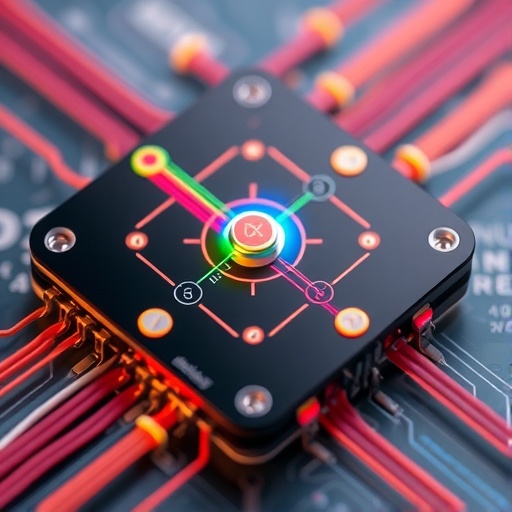A groundbreaking innovation in the field of cardiovascular medicine has emerged with the introduction of an iontronic tip-sensing guidewire (ITG). This revolutionary advancement addresses a critical medical challenge: the assessment of blood flow restrictions due to plaque accumulation in coronary arteries. This phenomenon is also known to cause stenosis, which is characterized by a narrowing of the arteries. Such stenosis significantly impedes blood flow, increasing the potential risk for life-threatening cardiovascular events, including heart attacks. While existing commercial pressure guidewires utilize optical, piezoresistive, or piezoelectric sensing technology to measure fractional flow reserve, these solutions come with a host of limitations, including high costs, brittleness, and limited manoeuvrability.
The newly developed ITG sets itself apart by incorporating a unique thin iontronic tip sensor within a traditional guidewire framework. This integration is made possible through an innovative iontronic-based signal transmission method, leveraging the inherent ionic properties of human tissues. This means that the ITG can perform effectively within the human body, ensuring precise measurements of intravascular pressure without the inherent disadvantages of traditional guidewire materials. What makes this technology particularly fascinating is its ability to detect subtle fluctuations in blood flow, crucial for accurately assessing the physiological impact of stenosis across coronary arteries.
Through the application of iontronic technology, any changes in intravascular pressure generate a capacitance difference at the interface between the guidewire’s metal and ionic gel. This principle enables the ITG to outperform existing commercial guidewires in measuring hemodynamic changes in real time. As a result, clinicians can make more informed decisions during interventions, facilitating timely medical interventions that could save lives. This capability to detect minute pressure changes in blood flow opens up new protocols for diagnosing and treating cardiovascular disorders, representing a marked improvement over previously available technologies.
The absence of embedded conductive leads in the ITG further enhances its functionality, ensuring a superior torque ratio. This critical advantage confers high manoeuvrability, allowing healthcare professionals to navigate complex or tortuous vascular pathways with greater ease when performing diagnostic or interventional procedures. In comparison, traditional guidewires often face challenges due to their rigidity and complexity. The design simplicity of the ITG combines cutting-edge technology with practical application, potentially improving clinical outcomes for patients worldwide.
The validation of the ITG’s effectiveness and sensitivity has been rigorously conducted through in vivo studies involving rabbit, goat, and pig models. Each of these trials has underscored the reliability and accuracy of measurements taken by the iontronic guidewire. This comprehensive approach to testing highlights the commitment to safety and effectiveness inherent in the development of the ITG. The results from these models demonstrate that the iontronic guidewire not only meets but exceeds the expectations set by conventional technologies, making significant strides toward the future of cardiovascular diagnosis and treatment.
Moreover, the compatibility of the ITG with existing commercial guidewires will pave the way for redesigning a plethora of interventional medical devices. This means that medical practitioners will be able to integrate this new sensor technology without the need for completely overhauling their existing systems. The routine use of ITG could herald a new standard of care in the management of cardiovascular diseases, simplifying procedural protocols and improving patient outcomes.
In the broader context of interventional cardiology, the implications of the ITG are profound. Given the prevalence of cardiovascular diseases globally, advances that enhance diagnosis and treatment are more important than ever. With the capacity to provide real-time feedback on blood flow dynamics, the ITG has the potential to fundamentally change how doctors assess and manage patients suspected of having significant coronary artery stenosis. The technology represents not merely an incremental upgrade to existing solutions but a seismic shift in how healthcare can leverage engineering innovations to improve patient care.
As the medical community continues to grapple with the increasing burden of cardiovascular diseases, findings such as those surrounding the iontronic tip-sensing guidewire become pivotal. They serve both as a reminder of the challenges that remain in treating these conditions and as a source of hope for future interventions. Innovations like the ITG signify that there are new frontiers to explore, where technology and medicine continue to converge, ultimately benefiting patients and the healthcare system alike.
The introduction of the iontronic guidewire exemplifies how ongoing research and innovation can yield solutions that significantly impact patient quality of life and mortality rates. With its ability to deliver precise measurements and promote better surgical outcomes, the ITG represents a beacon of hope for clinicians. As this technology gains traction, it will undoubtedly pave the way for a new generation of medical devices that leverage the ionic nature of human biology, ultimately leading to a more effective and efficient approach to cardiovascular health.
Future studies and clinical trials will be essential in assessing the long-term implications of the ITG’s integration into routine practice. Ongoing research efforts will be focused on refining the technology, exploring its applications in other vascular interventions, and integrating it with other technological advancements. This new frontier not only points to the emerging role of iontronic devices in medicine but also underscores the importance of interdisciplinary collaboration in driving innovation in this vital sector of healthcare.
The iontronic tip-sensing guidewire is a testament to human ingenuity and the relentless pursuit of better therapies for complex health challenges. It reflects the commitment of researchers and clinicians who strive for excellence in patient care. As the landscape of medical devices continues to evolve, innovations like the ITG will lead the way forward, promising a future where all patients can receive the best possible care tailored to their unique physiological needs.
Subject of Research: Cardiovascular Innovations with Iontronic Technology
Article Title: Unveiling the Future of Cardiovascular Diagnosis: Introducing the Iontronic Tip-Sensing Guidewire
Article References:
Guan, F., Bai, N., Song, J. et al. Iontronic tip-sensing guidewires.
Nat. Biomed. Eng (2025). https://doi.org/10.1038/s41551-025-01548-9
Image Credits: AI Generated
DOI:
Keywords: iontronic technology, cardiovascular disease, guidewire innovation, intravascular pressure measurement, medical devices.




